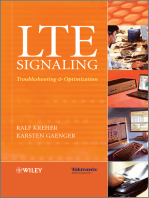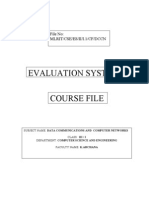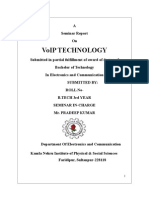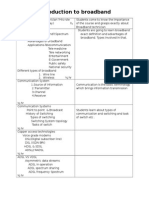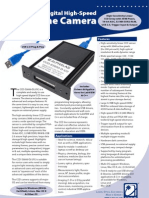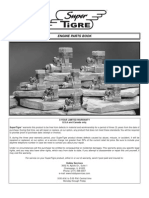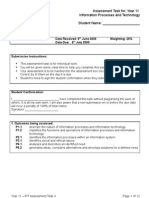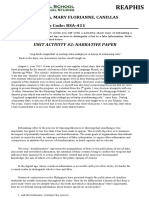Telematics (9175)
Telematics (9175)
Uploaded by
Gajanan BirajdarCopyright:
Available Formats
Telematics (9175)
Telematics (9175)
Uploaded by
Gajanan BirajdarCopyright
Available Formats
Share this document
Did you find this document useful?
Is this content inappropriate?
Copyright:
Available Formats
Telematics (9175)
Telematics (9175)
Uploaded by
Gajanan BirajdarCopyright:
Available Formats
Course Name: Electronics Engineering Group Course Code: EJ/ET/EX/EN/DE/ED/EI Semester : Sixth for ET/EJ/EN/EX/DE and Seventh for
ED/EI Subject Code: 9175
Subject Title : Telematics (Elective II) Teaching and Examination Scheme: Teaching Scheme TH 03 TU -PR 02 Paper Hrs 03 TH 80
Examination Scheme TEST 20 PR -OR 25# TW 25@ TOTAL 150
Rational:
In the telecommunication field still the landline telecommunication users are in huge amount because of clear and cheap service, so it becomes very essential to learn the different landline services, operations, and maintenance of telephone system. This subject is a technology subject which expert the student for fault finding, servicing & maintaining the telephone instrument and EPABX system. This subject covers the telephone instrument, switching, EPABX, cordless telephone, Fax, modem & ISDN. Objectives: The student will be able to: 1. 2. 3. 4. 5. 6. 7. 8. Identify different sections of telephone receiver. Identify different tones used in telephone exchange. Describe operation of cordless telephone. Explain different digital switching system. Explain analog and digital services. Explain Principle and services provided by ISDN. Install EPABX system. Explain the operation of FAX and modem .
Learning Structure:
Applications
Fault finding & trouble shooting of Telephone set. Fault finding & installation of EPABX, FAX, Modem. Understanding of Digital servicing & protocol.
Procedure
Block diagram of Electronic telephone & cordless telephone. Call processing in Electronic exchange. Block diagram of EPABX, FAX, Modem. Architecture of ISDN.
Principle
Stored program control. DSL, ADSL, DPS, DS. Principle of digital Telephony. PRI, BRI.
Concept
Different tones in Electronics exchange. Switching ( circuit, Packet, message). Data compression & image processing. Protocol.
Fact
Telephone, signal, tone.
Contents: Theory Chapter 01 Name of the Topic Telephone Instrument and signals 1.1 Introduction. 1.2 Telephone receiver 1.2.1. Block diagram & operation of electronic telephone. 1.3 Tones used in telephone exchange dial tones, busy tone, ring tone, number unobtainable tone. 1.4 Touch tone (DTMF) 1.5 Block diagram of cordless telephone system 1.5.1 Frequency allocation. Digital Switching System. 2.1Introduction 2.2 Classification of switching system 2.3 Telecommunication network trunks, subscriber lines, 2.4 Basic of switching system.- Inlets, outlets symmetric network, folded network, blocking network, non blocking network 2.4.1 Elements of Switching system 2.5 SPC (Stored program control) 2.6 Centralize SPC 2.7 Distributed SPC 2.8 Enhanced services 2.9 Telephone Network 2.9.1 Subscribers loop system MDF, MF,FP, BF,DP,DC,DW 2.9.2 Switching Hierarchy routing 2.9.3 Numbering plan- Telephone number. Analog, Digital Services and Applications of Telecommunication.( only informative treatment ) 3.1 Analog services Switched, leased, local call service, Toll call services, 800 services, WATs, 900 services. 3.2 Digital services- switched / 56, Digital data service (DDS), Digital signal services (DS). 3.3 Digital subscriber line (DSL) ADSL. 3.4 Business applications of telecommunication 3.4.1 Automated teller machines(ATM) 3.4.2 Videoconferencing 3.4.3 Banking, Shopping 3.4.4 Telecommuting Hours 04 Marks 08
02
08
12
03
08
12
04
05
06
07
3.4.5 Distance Learning, Telemedicine ISDN. 4.1 Motivation for ISDN 4.2 Services provide by ISDN. 4.3 X. 400 family of standards 4.4 Architecture of ISDN. 4.5 ISDN rate access interface 4.5.1 Primary rate access (PRI) interface. 4.5.2 Basic rate access (BRI) interface 4.6 Message format for ISDN 4.7 ISDN address structure 4.8 Broad band ISDN. 4.9 Introduction to FAX 4.10 Working principle of FAX. 4.11 Image processing. 4.12 Data compression 4.13 Block diagram & operation of FAX machine. 4.15 Introduction to Modem. 4.16 Working principle of Modem. 4.17 Types of Modem- Synchronous, A Synchronous, half duplex & full duplex. 4.18 Block schematic of Modem. 4.19 ADSL & cable Modem Telephone Instrument ( DTMF) 5.1 Tone Type 5.2 MF 5.3 Wireless Telephone 5.4 FAX 5.5 ISDN Installation 5.6 ISDN Procedure 5.7 PRZ, BRZ Line 5.8 ISDN telephone 5.9 FAX 5.10 Conferencing 5.11 Internet EPABX (Electronic private automatic business exchange). 5.1 Block diagram 5.2 Signal Processing (working) 5.2.1 Analog CMOS cross point switch. 5.2.2 Digital TDM / PCM switch. 5.2.3 Installation procedure for EPABX. EPABX 7.1 Installing Procedure
08
14
04
08
08
12
08
14
7.2 Programming on Console, on terminal, on computer 7.3 Maintenance technique 7.4 Voice Over IP Phone 7.5 Wiring Diagram Total Practical: Skills to be developed: Intellectual Skills: 1. Reading 2. Sourcing of Web sites Motor Skill: 1. Testing 2. Measurement List of Practical: 1. 2. 3. 4. 5. 6. 7. 8.
48
80
Testing and installation of fixed telephone Testing and installation of cordless telephone Visit to Telephone exchange and prepare report. Draw the layout of given EPABX system. Installation and testing of EPABX system. Preparation and installation of wiring layout using MDF, CT boxed box. Installation of FAX machine. Installation of MODEM.
Learning Resources: Books: Sr. No. 01 02 03 04 05 Author T. Vishwanathan Louis E. Frenzel Behrouz A. Forouzan N.N Biswas H. Carr and C. Snyder Title Telecommunication switching systems and networks Communication Electronics Data Communication working Principle of Telephony Management of Telecommunication Publisher Prentice Hall of India Tata McGraw-Hill Tata McGraw-Hill Tata McGraw-Hill
You might also like
- Telecom 101 Reference BookDocument16 pagesTelecom 101 Reference BookOdoch HerbertNo ratings yet
- The Impact of Wage On Employee ProductivityDocument6 pagesThe Impact of Wage On Employee ProductivityImelda Arreglo-Agripa70% (10)
- Indoor Radio Planning: A Practical Guide for 2G, 3G and 4GFrom EverandIndoor Radio Planning: A Practical Guide for 2G, 3G and 4GRating: 5 out of 5 stars5/5 (1)
- LTE Signaling: Troubleshooting and OptimizationFrom EverandLTE Signaling: Troubleshooting and OptimizationRating: 3.5 out of 5 stars3.5/5 (2)
- 3rd Chapter Medical Physics Notes by Abdul Ghafoor Sajjad Physiotherapist AFIRMDocument9 pages3rd Chapter Medical Physics Notes by Abdul Ghafoor Sajjad Physiotherapist AFIRMAbdul Ghafoor Sajjad64% (11)
- Bachelor of Engg PuneDocument30 pagesBachelor of Engg PuneKapil Kotangale100% (1)
- TCM CompsDocument6 pagesTCM CompsmirkofedorNo ratings yet
- Architectural Choices For Packet Switched Telephone NetworksDocument15 pagesArchitectural Choices For Packet Switched Telephone Networkseugene123No ratings yet
- VOIPDocument79 pagesVOIPKhalid Khalifa AtyaNo ratings yet
- Data Communications and Computer NetworksDocument38 pagesData Communications and Computer Networkskumararchana0% (1)
- Mmak Msi 204Document9 pagesMmak Msi 204Nadia BakerNo ratings yet
- IsdnDocument18 pagesIsdnmayakrishnanbsnlNo ratings yet
- Seminar ReportDocument39 pagesSeminar Reportbetu8137No ratings yet
- PSTNDocument24 pagesPSTNAmber YounasNo ratings yet
- E1-E2 - Text - Chapter 6. PSTN NETWORK - SERVICESDocument9 pagesE1-E2 - Text - Chapter 6. PSTN NETWORK - SERVICESabhimirachi7077No ratings yet
- PSTNDocument24 pagesPSTNAmber YounasNo ratings yet
- Transmission and Media: Ir. Muhamad Asvial, MSC., PHDDocument48 pagesTransmission and Media: Ir. Muhamad Asvial, MSC., PHDanurkumalaNo ratings yet
- Project ReportDocument23 pagesProject ReportDhruv BhandariNo ratings yet
- 05 TelecommDocument27 pages05 TelecommbabubmNo ratings yet
- BSNL Intership Program Report Sem2Document54 pagesBSNL Intership Program Report Sem2Aswin PPNo ratings yet
- Elex & TelecomDocument12 pagesElex & TelecomBipul KumarNo ratings yet
- Telecom Equipment Technology: A Summer Training Report OnDocument32 pagesTelecom Equipment Technology: A Summer Training Report OnAditya ShuklaNo ratings yet
- Group Members Amber Younas E07-009 Muhammad Ramzan E07-042Document24 pagesGroup Members Amber Younas E07-009 Muhammad Ramzan E07-042Amber YounasNo ratings yet
- Introduction To BroadbandDocument7 pagesIntroduction To BroadbandAbhishek DebNo ratings yet
- TM2 User Manual en 2007 05 08Document29 pagesTM2 User Manual en 2007 05 08Vash TesterNo ratings yet
- Mahanagar Telephone Nigam Ltd. (MTNL)Document21 pagesMahanagar Telephone Nigam Ltd. (MTNL)indianmeghaNo ratings yet
- Lab 1 Rev01Document7 pagesLab 1 Rev01hashim rusliNo ratings yet
- L1.0-Evolution of Switching SystemDocument8 pagesL1.0-Evolution of Switching SystemMohith RSNo ratings yet
- Telia User Guide Eng 051218Document23 pagesTelia User Guide Eng 051218Zoltn BukaNo ratings yet
- OHIO State Voice Tech ReferencesDocument20 pagesOHIO State Voice Tech Referencesvicente200dasilvaNo ratings yet
- Learntelecoms Startel: Interactive E-Learning Suite of CoursesDocument6 pagesLearntelecoms Startel: Interactive E-Learning Suite of CoursesSry SantosNo ratings yet
- Outline: EE 179: Introduction To CommunicationsDocument8 pagesOutline: EE 179: Introduction To CommunicationsThủy Hoàng MinhNo ratings yet
- RA1611003011229Document23 pagesRA1611003011229Shiv Pratap SinghNo ratings yet
- ContentsDocument42 pagesContentsbohnisikhadNo ratings yet
- BSNL TrainingDocument25 pagesBSNL TrainingAditya Dandotia68% (19)
- Mcit - Ethio Joint Team Training MaterialDocument56 pagesMcit - Ethio Joint Team Training MaterialMuhammedYeshaw67% (3)
- (Voice Over Internet Protocol) : Department of Electronics & Communication Govt Engineering College ThrissurDocument44 pages(Voice Over Internet Protocol) : Department of Electronics & Communication Govt Engineering College Thrissuryuben josephNo ratings yet
- Telecommunication TerminalsDocument13 pagesTelecommunication TerminalsMiki ArsovskiNo ratings yet
- Industrial Training Seminar On BSNL: Submitted ByDocument36 pagesIndustrial Training Seminar On BSNL: Submitted ByRAVIOOO7No ratings yet
- Chapter08.PSTN Network and ServicesDocument8 pagesChapter08.PSTN Network and ServicesdopesrinathNo ratings yet
- EPABX ReportDocument6 pagesEPABX ReportHarekrushna NandaNo ratings yet
- A Presentation On An Industrial Training Taken at CTTC-Kolkata (BSNL)Document26 pagesA Presentation On An Industrial Training Taken at CTTC-Kolkata (BSNL)Tajinder SinghNo ratings yet
- Industrial Training Seminar: Presented By: Anil Kumar Ece 7 Sem. 1311253002Document40 pagesIndustrial Training Seminar: Presented By: Anil Kumar Ece 7 Sem. 1311253002Anil Nagpal0% (1)
- RA1611003011229Document23 pagesRA1611003011229Shiv Pratap SinghNo ratings yet
- Ehome Prototype Desig N: Shyh-Kang JengDocument50 pagesEhome Prototype Desig N: Shyh-Kang JengDileep guptaNo ratings yet
- Metro Tel: Corporate IP-Telephony ServiceDocument9 pagesMetro Tel: Corporate IP-Telephony ServiceSuraiya Binte Azad100% (1)
- Telecommunication Switching Technology - 3 Ov: Rka - Raimo Kantola, ML - Marko LuomaDocument15 pagesTelecommunication Switching Technology - 3 Ov: Rka - Raimo Kantola, ML - Marko LuomaMehmar AsadNo ratings yet
- Comptia Convergence +: Certification Study GuideDocument50 pagesComptia Convergence +: Certification Study Guidebbbx22No ratings yet
- Cisco Voice Notes Part 1Document14 pagesCisco Voice Notes Part 1Mohammed Nehal AktherNo ratings yet
- Alcatel Telephone ManualDocument14 pagesAlcatel Telephone ManualScribdTranslationsNo ratings yet
- Bee4102 Chapter 5Document15 pagesBee4102 Chapter 5Amanya DenisNo ratings yet
- Ece-Viii-Wireless Communication (10ec81) - Notes PDFDocument108 pagesEce-Viii-Wireless Communication (10ec81) - Notes PDFSneha Upadhyayula100% (5)
- EC2015 7semand8th PDFDocument47 pagesEC2015 7semand8th PDFnadeemq_0786No ratings yet
- 1 - Introduction & PTCL PostnDocument68 pages1 - Introduction & PTCL PostnNaveed RamzanNo ratings yet
- Gigabit Ethernet Passive Optical NetworksDocument12 pagesGigabit Ethernet Passive Optical NetworksAna Soraya Dueñas OrtizNo ratings yet
- ISDNDocument17 pagesISDNRaymond GaboutloeloeNo ratings yet
- Wireless Technology - An Overview by Paul BuddeDocument14 pagesWireless Technology - An Overview by Paul BuddeManisha SinghNo ratings yet
- Data SheetDocument7 pagesData SheetJhoncito Hedy LaimeNo ratings yet
- BSNL Seminar Project by Abhishek & ShaniDocument27 pagesBSNL Seminar Project by Abhishek & ShaniabhishekNo ratings yet
- LG Aria Soho BrochureDocument6 pagesLG Aria Soho BrochureKhan JeeNo ratings yet
- Home Work Vi Sem Microwave IIDocument12 pagesHome Work Vi Sem Microwave IIGajanan Birajdar100% (1)
- Leaf and Flower Recognition System (E-Botanist)Document5 pagesLeaf and Flower Recognition System (E-Botanist)Gajanan BirajdarNo ratings yet
- DCE Assignments 2010Document7 pagesDCE Assignments 2010Gajanan BirajdarNo ratings yet
- ExplanationDocument8 pagesExplanationLaxmi GuptaNo ratings yet
- Dce SyllabusDocument3 pagesDce SyllabusGajanan BirajdarNo ratings yet
- Branch, Loop and Node Analysis: Principles of Electric Circuits - FloydDocument33 pagesBranch, Loop and Node Analysis: Principles of Electric Circuits - Floydtaha hashmiNo ratings yet
- Alphalas Advanced Digital CCD Line Camera Ccd-s3600-d (-Uv)Document6 pagesAlphalas Advanced Digital CCD Line Camera Ccd-s3600-d (-Uv)Rashika WimalarathneNo ratings yet
- Report Midterm Basic Principle of Project Mangement: I. Project 1. Introduction To Projects DefinitionDocument10 pagesReport Midterm Basic Principle of Project Mangement: I. Project 1. Introduction To Projects DefinitionHowlNo ratings yet
- Reported Speech 1Document3 pagesReported Speech 1Luigi OliNo ratings yet
- Radio Broadcasting ScriptDocument5 pagesRadio Broadcasting Scriptdonna belle m. intadNo ratings yet
- Second Language Learning JourneyDocument2 pagesSecond Language Learning JourneyMalakNo ratings yet
- 1592020110 XR01-02CX GB r1.2 16.01.13Document3 pages1592020110 XR01-02CX GB r1.2 16.01.13VIGNESH N RNo ratings yet
- Get Test Bank For Social Psychology 12th Edition by Myers Free All ChaptersDocument49 pagesGet Test Bank For Social Psychology 12th Edition by Myers Free All ChapterseszternisreNo ratings yet
- SGMW As Technical Assistance Center Maintenance BulletinDocument3 pagesSGMW As Technical Assistance Center Maintenance BulletinJuan Manuel Barrera MesaNo ratings yet
- Vizio PX65-G1 CNET Review Calibration ResultsDocument3 pagesVizio PX65-G1 CNET Review Calibration ResultsDavid KatzmaierNo ratings yet
- DLP in Math 8 ShainaDocument12 pagesDLP in Math 8 ShainaZandra QuillaNo ratings yet
- Cewe Digital Programmable Transducer User Manual Cewe BGX5 PDFDocument64 pagesCewe Digital Programmable Transducer User Manual Cewe BGX5 PDFsamijodoNo ratings yet
- Agro TextileDocument14 pagesAgro TextileASEEM SUPANNo ratings yet
- Demographia International Housing Affordability: 2024 EDITIONDocument33 pagesDemographia International Housing Affordability: 2024 EDITIONVeronica SilveriNo ratings yet
- Group 6 - Full Report Ice CreamDocument18 pagesGroup 6 - Full Report Ice Creamjoshia.djuhartoNo ratings yet
- Engine PartsDocument28 pagesEngine PartsBrandiece 'Dee Dee' Berry100% (1)
- KAMIYA - KAI-160 - SDS R2 - HSCRPDocument4 pagesKAMIYA - KAI-160 - SDS R2 - HSCRPangelinaNo ratings yet
- Parts Details LPG Compressors 3Document40 pagesParts Details LPG Compressors 3mohsen17183No ratings yet
- Dronetech Wbs Structure and Dictionary: Project Name: Wilmont Drone Case Revision No.: 3Document3 pagesDronetech Wbs Structure and Dictionary: Project Name: Wilmont Drone Case Revision No.: 3ShaunotNo ratings yet
- Ge 2 Final ExamDocument17 pagesGe 2 Final Examhoney balolongNo ratings yet
- 09 IPT Assessment Task 3 - Personal ProjectDocument12 pages09 IPT Assessment Task 3 - Personal Projectsedmondsbrown100% (2)
- SCP: Secret Laboratory Official WikiDocument5 pagesSCP: Secret Laboratory Official Wikieadfa dasdNo ratings yet
- ADL945PCDocument2 pagesADL945PCRaj ManiNo ratings yet
- Activity 5Document3 pagesActivity 5Sherly Borcena MaculaNo ratings yet
- Assignment # 03Document14 pagesAssignment # 03Zahoor AhmadNo ratings yet
- Reaphis: Unit Activity #2: Narrative PaperDocument3 pagesReaphis: Unit Activity #2: Narrative PaperMary Florianne DalinaNo ratings yet
- Ijetr011204 PDFDocument4 pagesIjetr011204 PDFerpublicationNo ratings yet
- DOC-20240917-WA0008.-pages-2 (2) - Pages-2Document53 pagesDOC-20240917-WA0008.-pages-2 (2) - Pages-2Meenu YadavNo ratings yet




